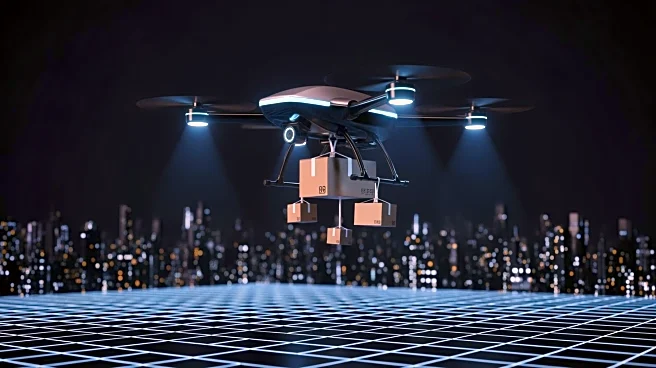What's Happening?
Researchers at TU Delft in the Netherlands have created an innovative algorithm that enables multiple autonomous drones to work together to transport heavy payloads. This development addresses the limitations
of single drones, which can only carry limited loads, making them unsuitable for tasks such as delivering heavy building materials or assisting in rescue missions. The new system connects multiple drones to a payload via cables, allowing them to lift and transport heavier objects while controlling their orientation. This capability is crucial for precise placement in complex environments. The algorithm allows drones to adjust their positions in real-time, responding to external disturbances like sudden payload movements. The system has been tested successfully in a controlled lab environment, using up to four drones at once and simulating various conditions such as wind and moving payloads.
Why It's Important?
The development of this algorithm has significant implications for industries that require the transportation of heavy materials in challenging environments. By enabling drones to carry heavier loads, this technology could revolutionize logistics in remote construction, agriculture, and search and rescue operations. The ability to transport heavy payloads autonomously and efficiently could reduce the need for human intervention in dangerous or hard-to-reach areas, potentially lowering costs and increasing safety. Furthermore, the flexibility and robustness of the system, which can adapt to changing payloads and external forces, make it a versatile tool for various applications. This advancement could lead to increased efficiency and effectiveness in industries that rely on the transportation of heavy goods.
What's Next?
The TU Delft team plans to prepare the technology for real-world deployment. Currently, the system uses external motion capture cameras for indoor testing, which limits its use in outdoor environments. The researchers aim to overcome this limitation to enable outdoor applications. Potential future uses include search and rescue missions, where drones could deliver supplies or evacuate individuals from hazardous areas, and agriculture, where they could transport large quantities of crops. The team is focused on refining the technology to ensure it can operate effectively in diverse and unpredictable real-world conditions.













